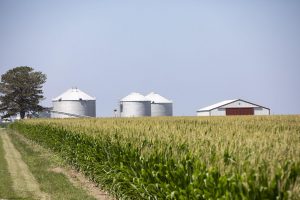Run-up in food, farmland prices could ease
By Daniel Grant FarmWeek — April 19, 2023
The Food and Agricultural Policy Research Institute at the University of Missouri predicted that food and farmland prices could return to more normal rates of inflation later this year and into 2024. (Photo courtesy of Illinois Farm Bureau)
Buyers of everything from food to farmland could see a return to more normal rates of inflation later this year and into 2024.
The Food and Agricultural Policy Research Institute (FAPRI) at the University of Missouri predicted the economic shift recently in its annual U.S. Baseline Outlook report.
“Net farm income is likely to fall back from the record levels of 2022 and consumer food price inflation is also likely to slow in 2023,” said Pat Westhoff, FAPRI director.
Food price increases have slowed in recent months, to 0.4 percent between January and February, and are projected to rise 4.4 percent through 2023, according to FAPRI. However, food prices were still up 9.5 percent in February compared to last year.
Next year, food price inflation could ease to a more normal range around 2 percent, according to the report.
If realized, a slowdown of food price inflation would be welcome news for consumers who endured a 9.9 percent hike last year, the highest since 1979.
“Consumer food price inflation jumped to 9.9 percent (in 2022) as farm commodity prices rose, labor and other costs increased, supply chain problems continued and consumer demand was strong,” the FAPRI report noted.
This year, FAPRI looks for a reduction in crop and livestock prices and a smaller increase in production expenses. Lower prices for some inputs could result in a reduction of production costs by 2024 and 2025.
“What goes up, generally comes back down in the agricultural markets,” Westhoff said. “Projected prices for most crops, poultry and dairy products all retreat in 2023 from recent peaks, and so do some production expenses.”
FAPRI’s baseline estimates suggest crop prices could fall from averages in 2022-23 of $6.69 per bushel for corn, $14.23 for soybeans and $9.08 for wheat to $5.32, $12.17 and $7.39 in 2023-24 and down to $4.84, $11.82 and $6.60, respectively, by 2024-25.
Of course, the price estimates are based on expectations of increased ag output.
“If weather conditions allow crop yields to return to trend-line levels in 2023, prices for corn, soybeans, wheat, cotton and many other crops are likely to fall,” FAPRI noted.
Over the next 10 years, average nominal crop prices could be much lower than they have been in 2022-23, but remain above the average of 2017-18 and 2021-22, according to the report.
The expected drop in farm income and rise in interest rates could significantly cool the farmland market, which saw Class A land values increase a whopping 45 percent from 2021 to 2022 statewide, according to the Illinois Society of Professional Farm Managers and Rural Appraisers.
After a ninth-straight increase last month, the benchmark federal funds rate is up to a range of 4.75 percent to 5 percent, which pushed borrowing costs to the highest level since 2007.
“Farm asset values have increased with land prices in recent years, and another increase is projected for 2023,” FAPRI stated. “Given assumptions of the outlook, lower farm income and high interest rates restrict further increases in farm real estate values in subsequent years.”
This story was distributed through a cooperative project between Illinois Farm Bureau and the Illinois Press Association. For more food and farming news, visit FarmWeekNow.com.



